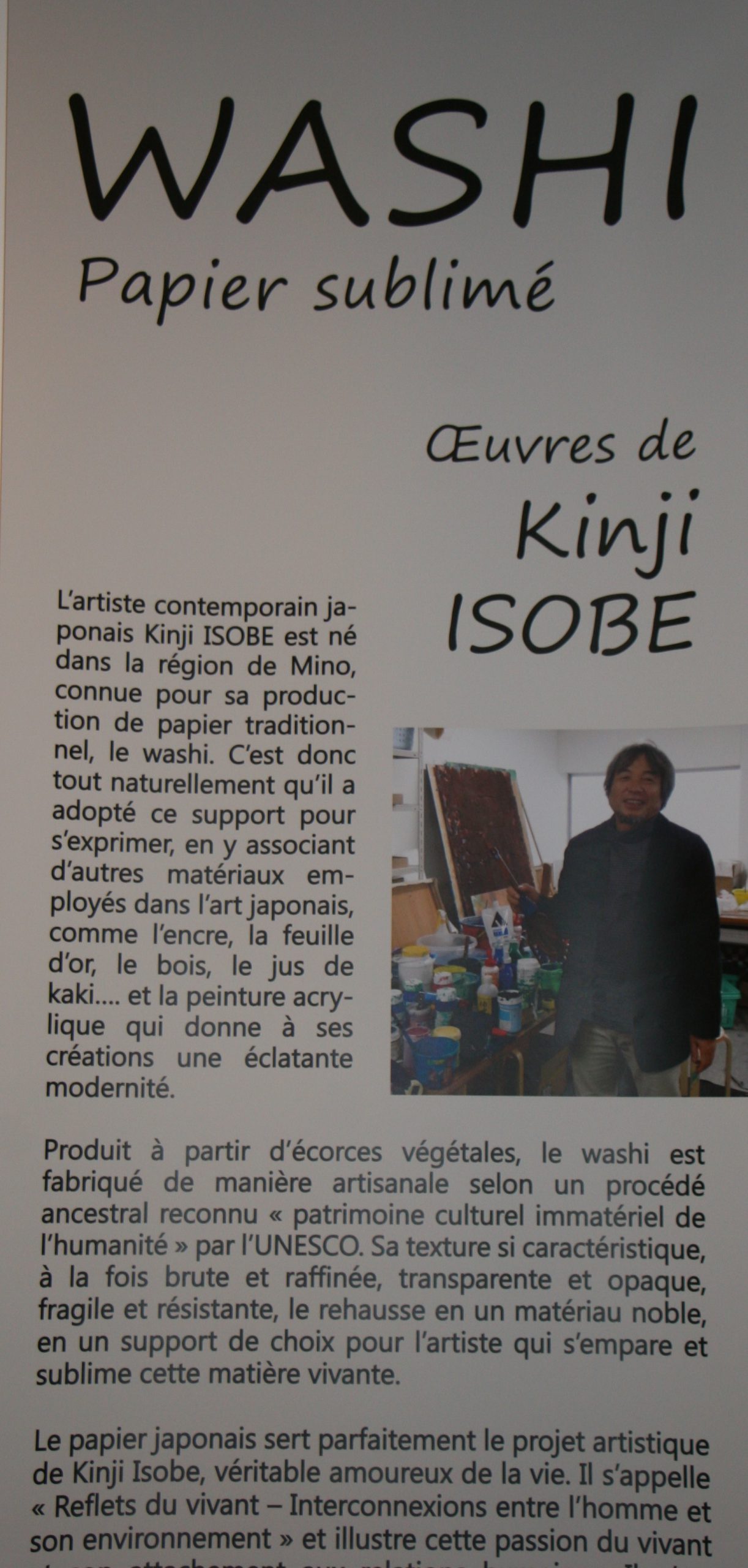ニース・アジア美術館(フランス,2016)
Musée des Arts asiatiques,Nice (France)
Hélène CAPODANO CORDONNIER
(Musée des Arts asiatiques, Nice)
L’artiste contemporain Japonais Kinji Isobe est originaire de la région de Mino, connue pour produire le washi, le papier traditionnel japonais. C’est donc tout naturellement que l’artiste a adopté ce support
pour s’exprimer, en y associant d’autres matériaux employés dans l’art japonais, comme l’encre, la feuille d’or, le bois, le jus de kaki… et la peinture acrylique qui donne à ses créations une éclatante modernité.
Force du trait et des couleurs, calligraphie, usage de symboles, mélange de matières, inclusions, collages… Le travail de l’artiste, riche et inventif, le mène à s’approprier comme nul autre ce support à la texture si caractéristique,pour renouveler l’art pictural du kakemono.
Hélène CAPODANO CORDONNIER (ニース・アジア美術館)
現代絵画芸術家である磯部錦司は日本の伝統的和紙の生産で名高い美濃地方の出身である。故に芸術家としての自己表現をこの和紙に託したのは全く自然な事でありましょう。和紙の上に墨、金箔、木、柿汁等あらゆるマチエールを用いて描き、さらにアクリル絵の具を取り入れることにより、現代美術創作の輝きがそれら作品に与えられています。力強い線と色彩、見事な書の筆使い、シンボルの使用、物質の混合、嵌め込みとコラージュ…等、創意豊かなこの作家の仕事は他に類を見ないほど個性に満ちた構成であり、掛け物絵画の革新的作品となっているのです。
(Hélène CAPODANO CORDONNIER「 美術館リーフレット」 2016 翻訳 田島美保子 氏)
富山県美術館 (1992)
Toyama Prefectural Museum of Art & Design
Kenji Otsubo(Toyama Prefectural Museum of Art & Design)
In recommending artists for this exhibition, I wanted to giveattention to artists whose work is related to the present day but quite different from what is ordinary called “contemporary art”. Of course, the definition of contemporary art has become rather vague, so it may seem meaningless to talk about distance from it or how to get away from it since these relative matters, Still, since the “contemporary art” of Japan is a product of the intellectual milieu and urban commotion of Tokyo, one might look to the work of artists with a regional haracter and orientation to find important features which have been lost from more fashonable painting. Isobe was born in Gifu prefecture, studied in Niigata, and returned to Gifu. His eloquent paintings make use of a boldy expressive combination of collage and calligraphy to give us a sense of time and meaning which has been lost from the urban art of today. Just as an elderly artist produces paintings which could only be painted in old age, Isobe creates strong, emotinally expressive paintings which could only be made by someone rooted in the historical culture of his region.
大坪健二(富山県美術館)
……これまで東京などを中心に,日本の現代美術を推進させてきた精神風土や機動力とは別の風土性や回路から生まれ出てきた美術の存在は,私たちがとかく絵画や美術の世界から切り捨ててしまった諸問題を喚起させる貴重な力とはなりえないだろうか。
例えば磯部の画面は,今日、都会の美術が失ってしまった独特の時間の感覚や意味を、コラ-ジュと書という大胆な組み合わせによる表現を通して、私達に切実に問いかけて来る。年老いた画家が老いの中でしか描けない絵画があるように、磯部の作品には、実際に地方の歴史的風土に身を置かねば得られない絵の強さ、匂いを発散させている。
(「VOCA展―新しい平面の作家たち―」図録, 1994)
酒井忠康(神奈川県立近代美術館館長)
過去は現在にむかって変貌する──という考え方や見方がある。このことは、とくに美術について思念をめぐらすときに、もっとも顕著なかたちであらわれる。今日のわたしたちに過去がどのように映って見えるのか、というところに、その変貌の秘密が隠されているからである。現代の作家は未来をつよく意識すると同時に、この過去にも生きた時間をあたえなければ、本当の意味での創造的な活力は獲得されないだろう。
「日本海美術展」のおもしろさは、そうした変貌をとらえる「発見の眼」を、作家たちがそらぞれに自分のかたちにしているところにある。大賞の「激石波Ⅱ」は、日本海的風土のもつ気象のはげしさを大胆に表現している。
(「日本海美術展」図録, 1992)
ブランデ市(デンマーク 2001)
Brande City (Denmark)
Shunshou Manabe(Fine Art Critic)
Kinji Isobe’s works are generally classified as “contemporary art”, though there is always a strong awareness of Japanese culture. Of his many documentary works, what needs to be noticed is that they bear the principle issue of expression. Eastern spirit that you do not normally encounter in European pieces inhabits in Isobeʼs works. If you take a close look at his pieces, you will remember the “embodiment of unknown objects” in his circles, spaces and in his touches.
A series of activities in Denmark should attain high evaluation for giving significance to infinite symbols that lie in finiteness. Another remarkable activity called “Mino-washi (Japanese paper) Light Art Exhibition” was a successful harmony of Japanese paper and the old town lane and tender lightings.
We can realize the perpetual value in his certainly free execution.
With Isobeʼs drawing technique, he describes mother nature with coexisting trees in this “circles in resentation” I have no doubt that Isobe’s these unique documentary art works will cast a innovative notion to our chaotic world
(「Kinji Isobe Exhibition Drawing from Document」Catalog, Remisen Brande, Denmark, 2003)
真鍋俊照 (美術評論家)
磯部さんの作品の展開は、現代美術のジャンルに属するが、極めて日本文化の現象を意識した主張が常にある。その作品の多くはドキュメントであると思うが、表現の根源の問題を背負っているところに注目する必要がある。その多くはヨーロッパには見出しえない東洋の魂が宿っている点だ。しかも作品をよく見ると、円の中に、空間に、そして彼が表現体としてぶつけようとするタッチの中に、我々が忘れかけていた、あの「未知なるモノへの具現」が潜んでいる。とくに有限の中に眠っていた無限の記号に意味を与え続けたデンマークでの一連の活動は評価されなければならない。また美濃和紙を素材とした路上のコラボレーション「灯りの道」というポエジー(詩作)も見事な成果だ。つまり彼は実に自由に制作しているところに永続的価値を見出すことができる。
この度の「絵画の円環考」は、彼のドローイングの手法も加えて、自然の中に息づく木々の共生がテーマである。彼のこうしたドキュメントの異色作品群は、混沌とした現代に、大きな今日的意味を投げかけるに違いない。
(「Kinji Isobe Exhibition Drawing from Document」Catalog, Remisen Brande, Denmark, 2003)
「Kinji Isobe Exhibition: Drawing from Document」 Yasutaka Hiroe (2003)
「生まれてくる自由について」
廣江泰孝(岐阜県美術館学芸員)
今秋、磯部氏が岐阜県美術館の園庭で試みた、制作をとおしての子供たちとの意識の交歓のそれからを考えている。大勢の子供たちが参加したこのワークショップは、同館企画展の関連事業として開催された。真っ白な大きな和紙に絵の具を滴らせ、滲ませ、おっかなびっくり筆を走らせてみた異質な体験の成果は、その後、園庭の森の中に掛けられていたので、きっと美術館に来られた多くの方が目にされたに違いない。
こうした実験的な試みは、これまでにも国内外を問わず取り組んでおられるようで、美術教育に熱心な磯部氏ならではの発案と理解している。予てより、古からの時間の集積や人々との営みのうちに創造の発露を求めた氏の制作態度には、一念の思いを込めて今という時間のなかで大きな意味があると認めているが、子供たちとの共同制作をとおしての教え教えられる関係は、この作家本人にとってますます重要な位置を占めてきたかのように思われる。またそこから何かを探しているように思われる。
子供たちとの、その時、その瞬間の記録と言える色の痕跡は、結果として作品という成果をうみだしているのだが、重要なのことは、制作する環境として、共に関わることで起こる想定外の出来事が、素朴な気付きにはじまる体験となって、個々人々のそれまでの意識を揺り動かしてゆくというプロセスである。それはまさに想像することの喜びを伝える機会であり、明解に自己の存在を知る場とともなってゆく。これ以上、作家を鍛える場所があるのだろうか。制約も無理もない、自由な遊びのなかから得られた新たな発見が、繰り返し続くのならば、どんなに素敵なことかしれない。できれば終わりのない制作を希望する。政策の最中、ふとした発見から生まれてくる自由こそ、真の自由であり、磯部氏が求めて止まない「それから」があると思われる。
Yasutaka Hiroe(Gifu Museum Curator)
I am recalling Kinji Isobe’s project with children and turning my thoughts toward ‘thereafter’. The project was a challenge for Isobe, took place in a garden of The Museum of Fine Arts Gifu as a part of this museum’s special exhibition event. Many children took part in this workshop by dripping paint on washi (Japanese paper) or excitedly draw with brush. The effort of this project may have caught many people’s eye since it was displayed in the woods of the garden.
Despite the desire to talk about this great workshop more, I will hold myself to focus on the subject. Isobe has experienced many of these tentative activities in Japan and : overseas, but it is quite like him who has strong ardor towards art education. I always admire his execution attitude that is to be inspired by every hour and the every person he encounters in the daily life, and I believe it has a significant notion these days. Collaboration with children allows him to keep ‘teach and learn relationship’ that is becoming more and more important in his career. Not only that, he is also trying to attain something from it.
By using colors, the impression of Isobe’s every moment and time with children remain forever as a trace; and as a result, it produces a massive artwork. However, the process is the most important point in this case. The process of causing unpredictable outcome by involving each other, interfering each other’s sense. That is where he can teach the joy of creation as well as realizing himself. No other place can train an artist better. Everlasting new discovery under free environment with no restrain, no compulsion, is such a desirable circumstance. I just hope for an everlasting execution as well. The freedom that you find amid work, midst accidental discovery, is the true freedom and I think that is where Isobe finds ‘thereafter’ that he cannot stop seeking.
「磯部錦司展 ―Repetition?―」リーフレット,真鍋俊照 (2001)
真鍋俊照(美術評論家)
新進気鋭の磯部氏の作品は、これまでにも「交わりとしての生命(いのち)」をテーマにした、インパクトの強い作
品が多い。
今回の作品は、デンマークのアーティストレジデンスで制作したものに、「連続し交わる丸」をさらに発展させようとする意欲的なものである。私はこの彼の野外での行為も含めて、深い意味を感じている。特に、地球や生命全体から発信する限りない生命感を、単なるコラージュではない、命の根源に迫る現代の貴重な主張として受けとめている。この主張は、あらゆる現代芸術にとって、今日もっとも大切にしなければならない課題である。磯部氏はこの問題を、気候(日、雨、風)を感じながら制作したという。つまり五感をとおして、自分の身体は主体芸術を追求しながら、例えば樹齢何百年という欅を年輪にした青々とした円は、生命そのものの融合のシンボルである。私には、この青々とした色合いが、大きな輪となって無限大に広がることを示唆しているように見える。同時にこの輪は、生命を地球環境の中で守り、殺りくを繰り返さないというメッセージのシンボルのようにも受けとめられる。
今われわれに何が大切かと問うことに、磯部氏はこれまで、太い黒い線で禅画に近い輪を描いてきたが、今回は、青い生命のパイプを輪切りにして生命に置き換えるという大胆な発想に変えている。このことが、磯部氏の新しい制作メッセージである。私はこのメッセージの透明感のある主張に、具象を超越した、実に大きな表現力を感じる。ここに展示された作品は、この世に秘められた主体そのものの力である。
磯部氏は、94年以降、VOCA展選抜など活躍中で、また今年の夏、デンマークのブランデにおいて、現代美術の世界各国から20人の製作者として選ばれ、特に日本の古紙を素材に展開されている。デンマーク体験の成果を、この展示で大いに宣布してほしいと思う。
「磯部錦司展 ―Dialogue of Life」リーフレット (2008)
Monologue of The Circle
ななみ書房 長渡晃
ななみ書房の歩みは、2005年に始まった。ある友人を介しての磯部氏との出会いはその少し前だったのだが、その頃はこのような関係に発展するとは思ってもいなかった。出会いからまもなくのこと、事の流れから、磯部氏には ななみ書房 設立の後押しに加えて、ロゴマークや本のデザインなど、仕事に関する重要な部分で全面的に支援をしていただくことになった。
最初の本が刊行されたのは2006年2月であったが、肝心のブックカバーのスタイルがまだ決まっておらず、磯部氏に相談をさせていただいた。その相談を快く受けて、素材に作品を提供してくださりデザイナーの方も紹介してくださった。その結果、創立当初から ななみ書房 の本の表紙を磯部氏の作品が飾ることになり、完成した記念すべき最初の本は、とても重厚な印象のものとなった。
以来、作品はどれも引き込まれるような深い美しさを持つ感覚のものばかりである。また、それが積み上がっていくにつれ圧倒されるような力を感じるようになって、全体に安心する落ち着きを与えている。ななみ書房が待ち受けるいくつもの高波にもまれながらも確実に前進しているのは、巧みな色の組み合わせと大きな輪による絵の放つ力強さに守られているからかもしれないと思う。
昨年、今回の作品展の話がもち上がり、喜んで協力をさせていただくことにした。「命との対話」という磯部氏の主張は、目の前で命と向き合ってきた私の想いでもあるからである。今回の作品展で原画に触れれば、ますますその魅力に引き込まれるかもしれない。「命との対話」という大きなテーマを背景に描かれた作品に押されぬ出版を目指さなくてはならないと思っている。
「MONAKA」6号,森岡由紀子 (1993)

新潟日報「磯部錦司展」 (1993)

「BT美術手帳」美術出版社, 廣江泰孝 (1996)
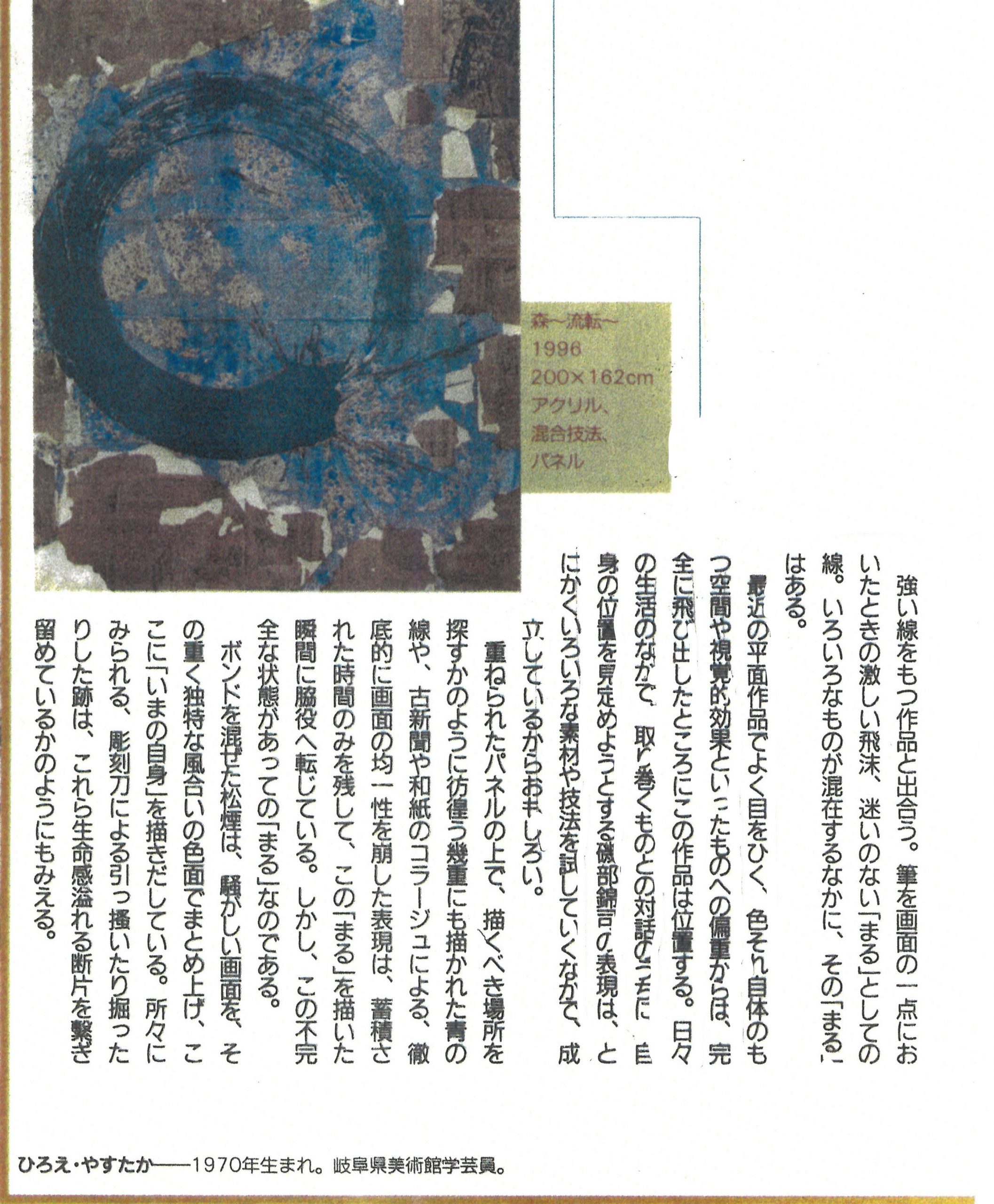
「中日新聞」 (1997)
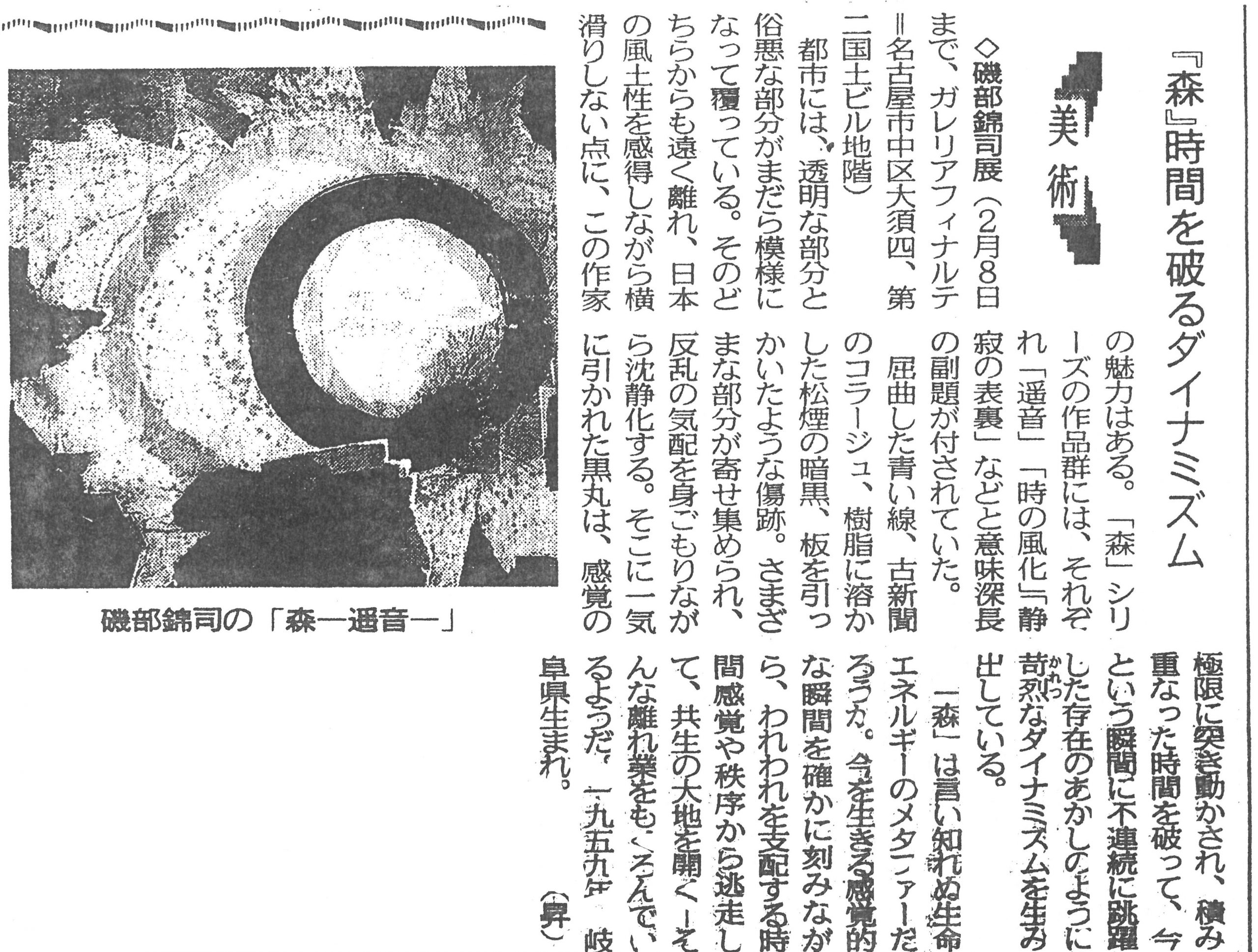
「中日新聞」 (1998)
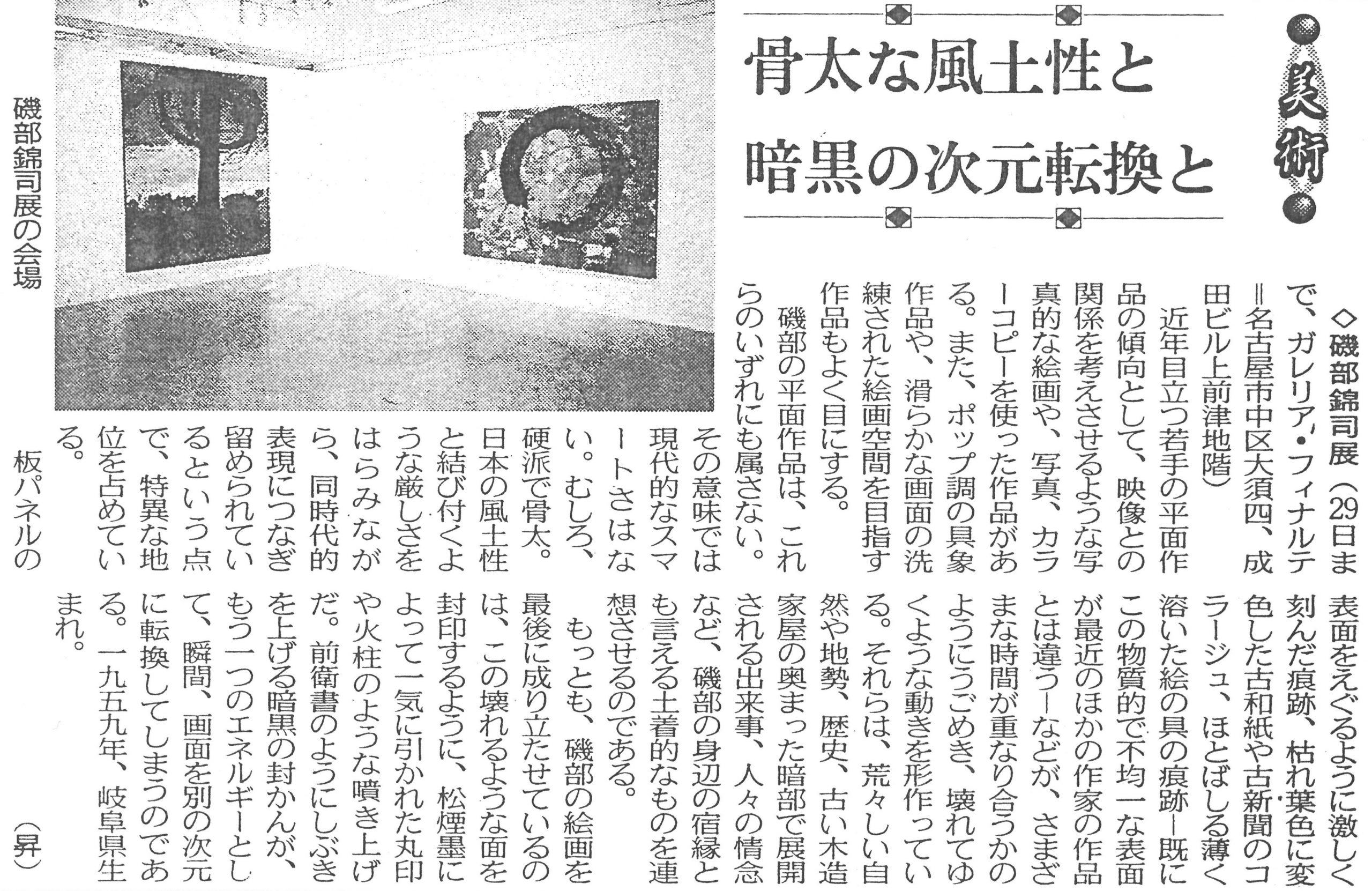
「中日新聞」 (2003)

“Exhibition Kinji Isobe” Randers. Denmark (2003)

ニース・アジア美術館 リーフレット (2016)
Musée des Arts asiatiques,2016
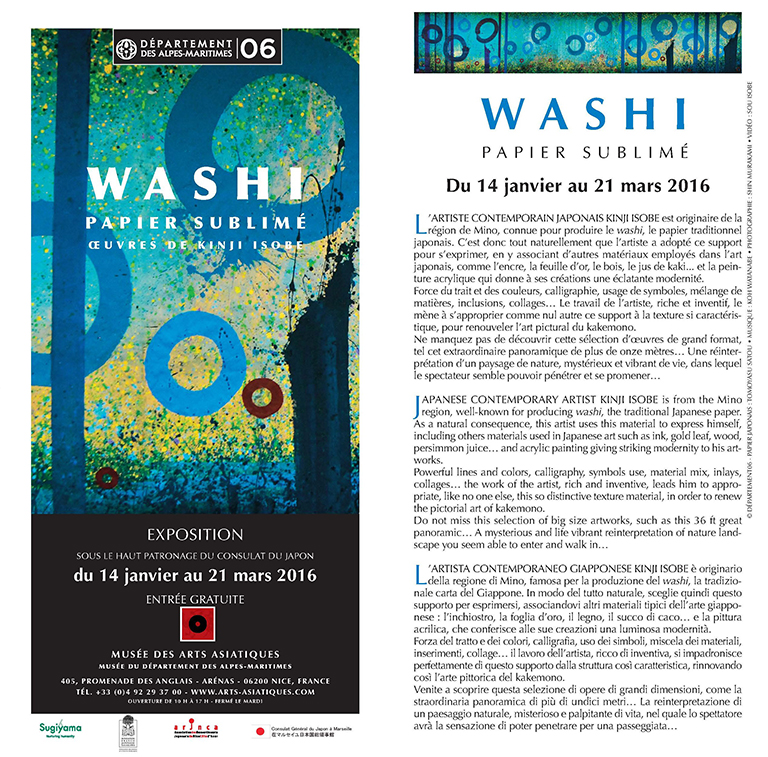
ニース・アジア美術館 リーフレット (2016)
Musée des Arts asiatiques,2016
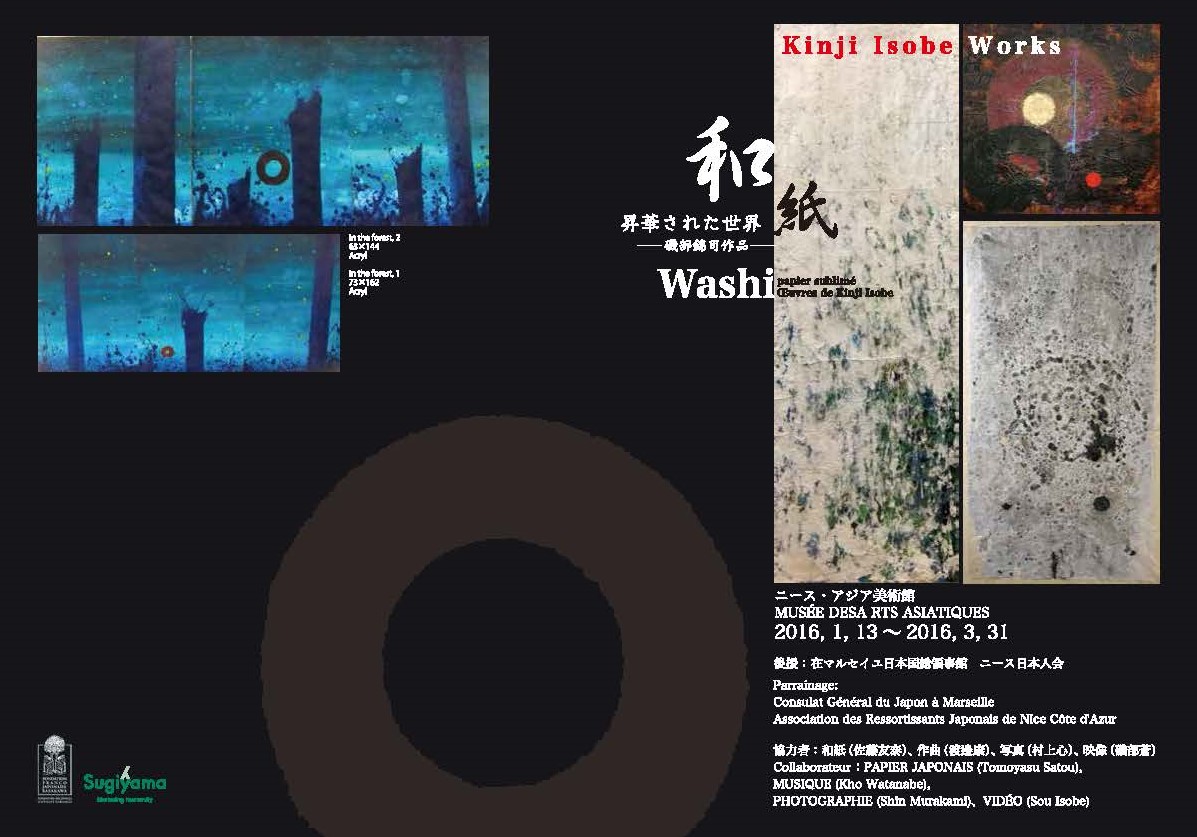
ニース・アジア美術館 リーフレット (2016)
Musée des Arts asiatiques,2016
